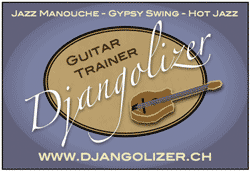
1 - How we learn things
There are two basic things to know about learning an instrument:- The cognitive learning
It is the understandig with your brain, the knowing, wich scale you can play over a certain chord, where the notes are, wich intervals are used in this scale and so on.It's important to repeat the learned things every day, for not forgetting them.
In this category you'll find the music theory. Thanks to Djangolizer, you don't have to study too much, because he shows you all the scales and connections you can use. If you want to learn more about music theory, ask your teacher or buy a good but easy understanding theory book.
But it will not help you, to study only the theory. You can't say: Well, I read a guitar method book, now I┤m a guitarplayer ;-)
Man learns by hearing, observing and of course trial and error...
- The learning by practicing
It means, to coordinate your fingers, to synchronise the movement of both hands and to train your muscles.Not only to avoid forgetting things, you need to repeat the themes and licks every day, but also to keep the speed you increased from practicing like a crazy the last few months.
In this category you'll find the technique. In the Gypsy Swing style this will be mainly the right hand picking.
When you can play all the scales, arpeggios and licks fluently, you have to put them in action.
You should be able to play them in any song in all the tonalities without thinking.
Djangolizer will help you, to practise that at home in peace, but a jam session or a concert, the songs will be played faster than usual and you maybe cannot hear yourself well enough and neither the rhythm guitar. If you can still blow all the licks easily with a smile in your face, then you got it, you became a master.
Practicing with the Djangolizer Demo-Version
The following chapters provide you a step by step guidance, to get into the principles of Gypsy Swing. You will learn, how to use the specialities of Djangolizer to help you practicing.The listed examples are all based on the songs of the Djangolizer Demo Version.
Djangolizer Power-User
There are some special exercises, only for the users of the full version of Djangolizer.How to practice?
In general
Choose in the chord table the appropriate chords and let them play in a loop.
You should start with a slow tempo of about 80 bpm. After 5 minutes of practicing, you can increase the tempo with 5 bpm. Advanced musicians can start with a higher tempo.
Take a break after these 5 minutes. Close your eyes and sit relaxed for about one minute. Give your brain the time, to store the learned stuff.
Practice short fragments. For example, practice to play an arpeggio upwards. After that, practice to play it downwards. After mastering that, play the arpeggio up and down.
--> playback manual
Guitar players:

In the demo version, you have only the choice of the fretboard-position 3 view (and "Full Fretboard"). Therefore are the axamples here written especially for that part of the fretboard.
The goal of a good guitar player is, to master all the arpeggios and scales over the entire fretboard, in all five positions.
--> fretboard manual
Other Instrumentalists:
The following examples are also displayed in score. Change to the score view, to see the exercises with notes.You can set there the tonality of your instrument, to see the proper notes.

--> score manual
Keycommands make your practice easier
The spacebar starts and stops
the playback.The key L toggles the playback between full song and single measures loop.
The keys N and M decrease and increase the tempo in 5 bpm steps.
You can move the cursor (red frame) with the arrow keys.



